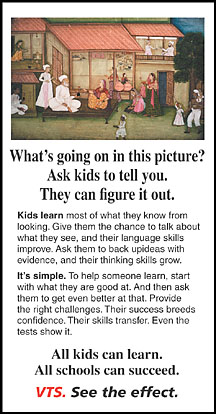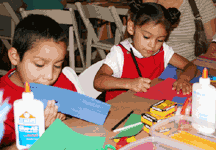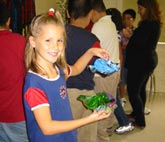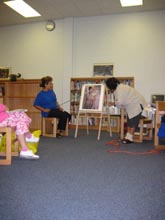 |
|
What
is VTS?
Visual Thinking Strategies (VTS), is an elementary and middle school
curriculum that:
- Uses a learner-centered method to examine and find meaning in
visual art
- Uses art to teach thinking, communication skills and visual
literacy
- Measurably increases observation skills, evidential reasoning,
and speculative abilities, and the ability to find multiple solutions
to complex problems
- Uses facilitated discussion to practice respectful, democratic
collaborative problem solving among students that transfers to
other classroom interactions and beyond
- Uses eager, thoughtful participation to nurture verbal language
skills, and writing assignments to assist transfer from oral to
written ability
- Uses the Web to develop independence and computer skills as
well as to assist teacher preparation
- Produces growth, including visual literacy and greatly enhanced
verbal and thinking skills, in all students, from challenged and
non-English language learners to high achievers
- Encourages art museum visits to underscore connections to art
and to integrate a community resource into students’ lives
- Meets state standards in art, language and social studies; improves
test scores in reading and writing
|
 |
|
The
VTS Method
- The VTS method is comprised of ten lessons per year, each lasting
approximately 45 minutes. Classroom lessons (1-9) focus on two
to three images provided as posters for grades K-2 and slides
for grades 3-5.
- Students are first asked to look at an image without talking.
Then the teacher/facilitator asks certain non-directive questions.
- "What's going on in this picture?"
- "What do you see that makes you say that?"
- "What more can we find?"
Museum/School Partnerships
- One important component is a museum visit (for 4th and 5th grade)
where students experience first-hand interaction with original
artwork in the museum environment.
- For a particular VTS Lesson, museum docents personally visit
an assigned school classroom to establish an integral part of
the program – the partnership between the docent and the classroom
teacher, and the relationship between the students and the museum.
|
 |
|
VTS Family Days
Family Day events are held at area museums to introduce parents to the method as well as the museum and its services.. These events incorporate the family unit into the learning process with the intent of servicing inner city and suburban families and creating long-range cultural patronage. VTS tours are provided for young patrons and their parents as well as creative hands-on art-making conducted by local artists.
VTS Family Day Themes
- "Egypt Revealed"
- "Animals and Art"
- "Singing Spirit / Dancing Spirit" celebrating the Meso-American
and Rockefeller Center for Latin American Art
- "Magic of Light" The American Impressionism VTS Family Day held
in conjunction with the Exhibition of the Treasures from the Smithsonian
Art Museum Show.
- "Japanese Festival Day" featuring the exhibit "Hanten and Happi:
traditional Japanese work coats from the Sumi Collection"
- "Moving Waters"
The response to these events has been overwhelming. Both children
and parents report great enthusiasm in discussing cultural artwork
and the opportunity to create new works in hands-on art-making activities.
Approximately 2,000 parents, children, and educators attend each
event.
For many families these events are a first-time visit to a museum
of any kind.
|
| |
|
Easy to Learn
- The VTS teaching method can be learned quickly: instructors ask only a few open-ended questions that are formulated to elicit thoughtful responses among beginning viewers. They paraphrase each student's answer, therefore assuring students that s/he understands and accepts their contribution, meanwhile ensuring that the whole class has heard the comment. They also acknowledge comments in another way, by continuously pointing to whatever students mention, which keeps eyes focused on the image. They facilitate the interactivity of the discussion by linking points of agreement and disagreement. Though simple, mastery of strategies -- the restraint of keeping to the question/response framework as well as paraphrasing/linking -- takes time.
|
 |
|
Training
- VTS involves a partnership between museums and schools, with
both classroom teachers and museum docents following the same
strategies. Training is based on the premise of the curriculum
itself: "self-discovery is a powerful way to learn and can be
facilitated by peer discussion guided by a syllabus focused on
questions, activities and reflection", says program founder Philip
Yenawine.
- VTS teachers attend training and debriefing sessions throughout the school year at local museums. Sessions practice the VTS instruction method, provide constructive feedback, monitor classroom progress, and establish a relationship between teachers and museum resources. Training is enriched by a combination of expert demonstrations, printed guides, videotapes, and Internet access to the program's designers. On-site professional development from VTS consultants provides efficient training and assurance that the methods are being accurately taught. In this respect, VTS differs from a school program in that the materials are supported by regular training and ongoing support.
- Manuals assist instructors in implementing the VTS method by
providing theory, rationale, lesson plans, images, exercises,
and methods for assessment. Abigail Housen, Ph.D., and Philip
Yenawine designed four manuals according to developmental levels,
which target Kindergarten through 8th grade. The user-friendly
manuals contain lessons, reproductions of images, journal pages,
and teacher exercises. For grades 3-8, there is a student writing
assignment component accessible via the internet.
- Because VTS has proven to advance communication skills
and shown transference to other disciplines, the method can be
used with all learning styles for students categorized as bilingual,
gifted, talented, special education, and underdeveloped talent.
VTS Images
- The art in VTS, while rich and diverse in cultures, periods,
styles, and media, has been chosen and sequenced to nurture interests
and abilities of beginning viewers. Both the teaching strategies
and the selections of high quality art are designed to support
the beginner’s needs and strengths, and to incite naturally paced
growth. This growth is stimulated by three components: art of
increasing complexity, group discussion as students respond to
developmentally based questions, and careful facilitation by instructors.
|
|
